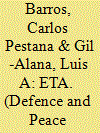|
|
|
Sort Order |
|
|
|
Items / Page
|
|
|
|
|
|
|
| Srl | Item |
| 1 |
ID:
090389


|
|
|
|
|
| Publication |
2009.
|
| Summary/Abstract |
In the last 15 years, terrorist activity in the Basque Country has substantially decreased and strategies have changed. Whilst the type of killings has become more specialised (politicians, reporters, etc.), a new phenomenon based on urban guerrilla tactics, and called in Basque 'kale borroka' (street fighting), has emerged, creating an atmosphere of violence in the streets. The contribution of this paper is threefold. First, we create a daily measure of the level of violence in the area. Second, we examine if police action and the repressive policy measures adopted by the government since 2001 have been effective in reducing the intensity of violence. Third, we investigate whether the level of violence has had an effect on the stock market index in the Basque Country. The results, based on daily data from 1 July 2001 to 15 November 2005, suggest that the only effective measure to reduce violence was the banning of Herri Batasuna (HB), the radical party close to ETA supporters. Moreover, there was a decrease in the stock market index as a consequence of the violence in the area during the period under analysis.
|
|
|
|
|
|
|
|
|
|
|
|
|
|
|
|
| 2 |
ID:
055215


|
|
|
| 3 |
ID:
069234


|
|
|
| 4 |
ID:
109429


|
|
|
|
|
| Publication |
2011.
|
| Summary/Abstract |
This paper investigates the integration properties of disaggregated solar, geothermal and biomass energy consumption in the U.S. The analysis is performed for the 1989-2009 period and covers all sectors which use these types of energy, i.e., transportation, residence, industrial, electric power and commercial. The results suggest that there are differences in the order of integration depending on both the type of energy and the sector involved. Moreover, the inclusion of structural breaks traced from the regulatory changes for these energy types seem to affect the order of integration for each series.
|
|
|
|
|
|
|
|
|
|
|
|
|
|
|
|
| 5 |
ID:
088994


|
|
|
|
|
| Publication |
2009.
|
| Summary/Abstract |
Previous studies that have tested for a unit root in aggregate energy consumption have potentially reached misleading conclusions because they fail to allow for the possibility that energy consumption might be fractionally integrated and do not distinguish between different types of energy consumption. This study tests for long memory in disaggregated petroleum consumption in the United States using univariate and multivariate Lagrange multiplier (LM) tests for fractional integration. The results point strongly to the need to distinguish between different forms of energy consumption and allow for a generalization of the I(0)/I(1) dichotomy when considering the order of integration of energy consumption. Allowing for short-run dynamics, the univariate test suggests that less than 50% of the series are fractionally integrated. Consistent with expectations the non-stationary series are found to have the highest mean and standard deviation. The multivariate test suggests that petroleum consumption in the commercial and industrial sectors is clearly fractionally integrated when allowing for short-run dynamics, and, as such, exhibits persistent effects, while petroleum consumption in the residential sector is a stationary process.
|
|
|
|
|
|
|
|
|
|
|
|
|
|
|
|
| 6 |
ID:
132625


|
|
|
|
|
| Publication |
2014.
|
| Summary/Abstract |
The main goal of this paper is to investigate whether the long memory behavior observed in many volatility energy futures markets series is a spurious behavior or not. For this purpose, we employ a wide variety of advanced volatility models that allow for long memory and/or structural changes: the GARCH(1,1), the FIGARCH(1,d,1), the Adaptative-GARCH(1,1,k), and the Adaptative-FIGARCH(1,d,1,k) models. To compare forecasting ability of these models, we use out-of-sample forecasting performance. Using the crude oil, heating oil, gasoline and propane volatility futures energy time series with 1-month and 3-month maturities, we found that five out of the eight time series are characterized by both long memory and structural breaks. For these series, dates of breaks coincide with some major economics and financial events. For the three other time series, we found strong evidence of long memory in volatility.
|
|
|
|
|
|
|
|
|
|
|
|
|
|
|
|
|
|
|
|
|